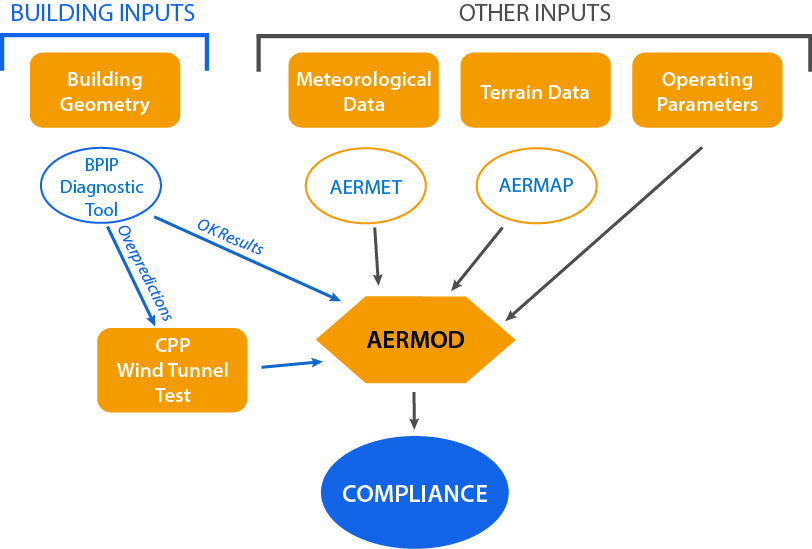News
CPP announces building downwash modeling tool
CPP is pleased to announce the release of a unique and innovative modeling tool that provides valuable information to facilities subject to permit modeling. This tool sheds light on building downwash effects which, while commonly ignored, are very important inputs to AERMOD. Building effects can often complicate the permitting process due to the inherent limitations in standard modeling techniques that tend to produce unrealistically high concentrations. Our BPIP Diagnostic Tool helps identify whether downwash effects are being accurately characterized in your modeling analysis. And it gives you the information you need to start overcoming them.
The problem
All proposed facilities and modifications that trigger dispersion modeling requirements have to undergo a rigorous air permitting process. Obtaining a permit for a power plant, manufacturing facility, refinery, chemical plant, steel mill, etc. means proving to the permitting authorities that the facility will meet the National Ambient Air Quality Standards (NAAQS), both in and around your facility. This is commonly done through dispersion modeling.
 AERMOD is EPA’s preferred regulatory model for air permitting to simulate the dispersion of pollutants after they are released into the atmosphere. But before AERMOD can work properly, you have to describe your building’s size and shape so that the software can calculate building downwash effects. That commonly means running a pre-processing tool called the Building Profile Input Program, or BPIP, to simplify and characterize the building structures in your facility.
AERMOD is EPA’s preferred regulatory model for air permitting to simulate the dispersion of pollutants after they are released into the atmosphere. But before AERMOD can work properly, you have to describe your building’s size and shape so that the software can calculate building downwash effects. That commonly means running a pre-processing tool called the Building Profile Input Program, or BPIP, to simplify and characterize the building structures in your facility.
Building dimension inputs are often overlooked, but may be one of the most important parts of the dispersion modeling process. AERMOD uses these values to estimate downwash, a flow effect induced by air that moves over and around structures. Downwash effects create localized flows that, instead of carrying pollutants horizontally and away from a facility, push them down to ground level, where they can accumulate and increase concentrations. The severity of this phenomenon is directly related to building size and shape, and the worse it gets, the less likely it is that your facility can meet air quality standards like the NAAQS.
In many cases, BPIP-generated building dimensions produce unrealistically high concentrations when run through AERMOD. That’s because AERMOD is optimized for solid, relatively small, box-shaped buildings. Of course, most buildings and structures of consequence aren’t shaped like small simple boxes. To further complicate the situation, AERMOD does not properly characterize porous and streamlined structures. These structures are also treated as solid, box-like structures in the model, which tends to produce an enhanced and unrealistic downwash effects. So running AERMOD with standard BPIP inputs may yield pollutant concentration estimates that are entirely too high due to these oversimplifications.
Unrealistic results waste your time and resources and can lead to unnecessary emission controls and taller-than-needed stacks. That’s why CPP developed the BPIP Diagnostic Tool.
Our solution
CPP’s wind experts are widely recognized as leaders in air quality and dispersion modeling. Our founders and engineers are well-respected members of the Air & Waste Management Association, American Meteorological Society and ASHRAE who—drawing on their professional accomplishments, academic reputations, and sophisticated understanding of wind effects—have influenced and even defined air quality best practices. Decades of experience have taught us that, despite AERMOD’s many strengths, it can do much, much better. This is especially true when refining the building inputs to the model with more accurate values.
We developed the BPIP Diagnostic Tool to help you decide whether AERMOD is likely to give accurate results or exaggerate the effects of downwash.
How does it work?
Our diagnostic tool checks building dimension values in your user-supplied BPIP output file and evaluates each of the 36 wind directions for each stack to identify building dimensions that are outside of the tested theory in the model.
Leveraging what we know about AERMOD—where it behaves and where it doesn’t—the tool then generates a report that indicates cases that may be problematic, giving you the information to decide whether standard BPIP methods accurately represent downwash effects, or whether building dimension refinements are warranted.
If the standard BPIP approach works for you, then you’re ready to go. But if the diagnostic tool flags a number of wind directions that might cause problems, you have the information you need to consider other, more accurate methods. CPP’s EPA-approved Equivalent Building Dimension (EBD) technique, for example, uses scale model wind tunnel testing to create a realistic BPIP file that works with AERMOD and gives you accurate results for situations involving building downwash.
Yes, it’s free
We invite you to take CPP’s new BPIP Diagnostic Tool for a spin. All you need is your BPIP output file (typically identified by a .bpo filename extension) and an internet connection: no software to download, no ads, and no fuss. Just upload your file and let the BPIP Diagnostic Tool analyze your building data. You’ll learn what wind directions are overstating downwash effects, and you’ll gain the critical data you need to make an informed decision. If the results indicate that alternate BPIP inputs will meet your needs, final BPIP dimensions must be confirmed with wind tunnel testing.
For more information, and to learn more about CPP’s BPIP Diagnostic Tool, contact us at marketing@cppwind.com
Put CPP’s expertise to work for you. We are pleased to offer a wealth of expertise in physical modeling, numerical modeling, and regulatory permitting to our clients. Our purpose is to deliver more accurate results, saving you time, money, and frustration.
